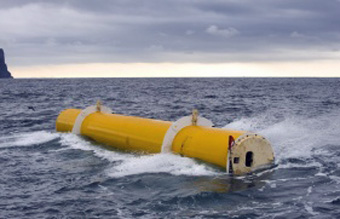Navigation
£5.1M Government Funding Secured To Develop Wave Energy Device, Oyster 2
Wave energy developer Aquamarine Power received a major boost on 2 February 2010 when it secured £5.1 million of public funding to support the manufacture of its second generation wave energy device, Oyster 2, which will be manufactured later this year for testing at the European Marine Energy Centre in Orkney (EMEC) in 2011.
 |
| The Oyster system consists of a hinged flap connected to the seabed at around 10m depth. Each passing wave moves the flap which drives a hydraulic piston to deliver high pressure water to an onshore turbine which generates electricity. Oyster is designed to capture the energy found in near shore waves in water depths between 10 and 20 metres. The benefit of Oyster is its simplicity. There are minimal moving parts and all electrical components are onshore, making it robust enough to withstand the rigours of Scotland’s harsh seas. A commercial farm of 20 Oyster 2 devices would provide enough energy to power more than 9,000 three bedroom family homes and offset carbon emissions of up to 20,000 tonnes.Photograph courtesy of Aquamarine Power |
Wave energy developer Aquamarine Power received a major boost on 2 February 2010 when it secured £5.1 million of public funding to support the manufacture of its second generation wave energy device, Oyster 2, which will be manufactured later this year for testing at the European Marine Energy Centre in Orkney (EMEC) in 2011.
Aquamarine Power received the grant from the Marine Renewables Proving Fund (MRPF), a £22 million initiative funded by the UK Government’s Department of Energy and Climate Change (DECC) and managed by the Carbon Trust. The fund aims to accelerate the leading and most promising marine energy devices towards the point where they can qualify for the UK Government’s existing Marine Renewables Deployment Fund support scheme and, ultimately, be deployed on a commercial scale. Aquamarine Power plans to deploy its first commercial Oyster devices in 2013.
The first generation 315kW Oyster device was officially connected to the National Grid at EMEC by Scotland’s First Minister Alex Salmond in November 2009 and is currently undergoing sea trials to gather data to finalize the Oyster 2 design, which will be deployed as a 2.5MW pod of three linked devices powering a single onshore hydro-electric generator. This follows a two year research programme including scale-model tank testing which was also part-funded by the Carbon Trust.
 |
| The marine energy industry could provide as many as 12,500 jobs, contributing £2.5 billion to the UK economy by 2020. Marine energy has the potential to meet up to 20% of the UK’s energy demands. Photograph from video courtesy of Aquamarine Power |
Videos of Oyster can be found at on Aquamarine Power's YouTube channel
The Oyster 2 device features a new shape designed for increased performance and efficiency – capturing more of the ocean’s energy and producing more power per tonne of steel. The device has also been designed for mass manufacture and will consist of a modular construction for ease of installation and maintenance. Multiple devices will share one pipeline and one onshore generator which will offer efficiencies of scale.
Martin McAdam, Chief Executive Officer of Aquamarine Power, said,“We’d like to thank the Carbon Trust and DECC for this funding and their contribution to the marine energy industry in the UK. This funding is just one of a whole raft of ways that they have supported Aquamarine at various stages in the growth of our business.
“The Carbon Trust, in particular, should be commended for the highly efficient way in which the scheme has been designed and managed, combining thorough due-diligence with a quick turnaround in assessing applications and allocating funding. This is of vital importance to protect the marine energy industry’s most precious commodity – time.”
“Over the last 18 months at Aquamarine Power we have built up a fantastic team with exceptional talent and expertise, we’ve successfully installed our first Oyster device, and we have secured substantial private investment – all in the face of the toughest economic climate.
“The future success of the marine energy industry is dependent upon continued public support to progress further technology development and, importantly, to de-risk and leverage private equity investment. We hope that this fund is the first step in putting in place a sustained programme of support to ensure that the marine energy industry meets its potential to deliver jobs for the UK economy and clean sustainable power to help meet climate change targets in the future.”
Notes:
• Aquamarine Power’s technical advisors include wave energy pioneers Professor Trevor Whittaker, head of the award-winning wave power research group at Queen’s University, Belfast, and Professor Stephen Salter, creator of the ‘Salter Duck.’
• Aquamarine Power has won numerous national and international awards for innovation in the renewable energy sector including ‘Innovator of the Year’ (British Renewable Energy Awards 2009), ‘Best Green Industry SME’ (Scottish Green Awards 2009) and The Engineer Award for Technology and Innovation in Energy’ (The Engineer Technology and Innovation Awards 2009).
• In 2007 Aquamarine Power joined forces with Scottish and Southern Energy subsidiary, Renewable Technology Ventures (RTVL), securing a £6.3m investment from SSE and a further £1.5m from Sigma Capital Group plc.
• Aquamarine Power has received significant funding and support from Scottish Enterprise, Highlands and Islands Enterprise, the Technology Strategy Board, the Royal Academy of Engineering, the Engineering and Physical Sciences Research Council (EPSRC), the Carbon Trust and the Scottish Government.
• Oyster is a registered trade mark of Aquamarine Power.
Note: An article about Oyster 1 is on Horizon International’s Solutions Site at www.solutions-site.org: Hydro-electric Wave Energy Device “Oyster” Launched Off the Coast of Scotland
This news is from Aquamarine Power, February 2, 2010.
Search
Latest articles
Agriculture
- World Water Week: Healthy ecosystems essential to human health: from coronavirus to malnutrition Online session Wednesday 24 August 17:00-18:20
- World Water Week: Healthy ecosystems essential to human health: from coronavirus to malnutrition Online session Wednesday 24 August 17:00-18:20
Air Pollution
- "Water and Sanitation-Related Diseases and the Changing Environment: Challenges, Interventions, and Preventive Measures" Volume 2 Is Now Available
- Global Innovation Exchange Co-Created by Horizon International, USAID, Bill and Melinda Gates Foundation and Others
Biodiversity
- It is time for international mobilization against climate change
- World Water Week: Healthy ecosystems essential to human health: from coronavirus to malnutrition Online session Wednesday 24 August 17:00-18:20
Desertification
- World Water Week: Healthy ecosystems essential to human health: from coronavirus to malnutrition Online session Wednesday 24 August 17:00-18:20
- UN Food Systems Summit Receives Over 1,200 Ideas to Help Meet Sustainable Development Goals
Endangered Species
- Mangrove Action Project Collaborates to Restore and Preserve Mangrove Ecosystems
- Coral Research in Palau offers a “Glimmer of Hope”
Energy
- Global Innovation Exchange Co-Created by Horizon International, USAID, Bill and Melinda Gates Foundation and Others
- Wildlife Preservation in Southeast Nova Scotia
Exhibits
- Global Innovation Exchange Co-Created by Horizon International, USAID, Bill and Melinda Gates Foundation and Others
- Coral Reefs
Forests
- NASA Satellites Reveal Major Shifts in Global Freshwater Updated June 2020
- Global Innovation Exchange Co-Created by Horizon International, USAID, Bill and Melinda Gates Foundation and Others
Global Climate Change
- It is time for international mobilization against climate change
- It is time for international mobilization against climate change
Global Health
- World Water Week: Healthy ecosystems essential to human health: from coronavirus to malnutrition Online session Wednesday 24 August 17:00-18:20
- More than 400 schoolgirls, family and teachers rescued from Afghanistan by small coalition
Industry
- "Water and Sanitation-Related Diseases and the Changing Environment: Challenges, Interventions, and Preventive Measures" Volume 2 Is Now Available
- Global Innovation Exchange Co-Created by Horizon International, USAID, Bill and Melinda Gates Foundation and Others
Natural Disaster Relief
- STOP ATTACKS ON HEALTH CARE IN UKRAINE
- Global Innovation Exchange Co-Created by Horizon International, USAID, Bill and Melinda Gates Foundation and Others
News and Special Reports
- World Water Week: Healthy ecosystems essential to human health: from coronavirus to malnutrition Online session Wednesday 24 August 17:00-18:20
- STOP ATTACKS ON HEALTH CARE IN UKRAINE
Oceans, Coral Reefs
- World Water Week: Healthy ecosystems essential to human health: from coronavirus to malnutrition Online session Wednesday 24 August 17:00-18:20
- Mangrove Action Project Collaborates to Restore and Preserve Mangrove Ecosystems
Pollution
- Zakaria Ouedraogo of Burkina Faso Produces Film “Nzoue Fiyen: Water Not Drinkable”
- "Water and Sanitation-Related Diseases and the Changing Environment: Challenges, Interventions, and Preventive Measures" Volume 2 Is Now Available
Population
- "Water and Sanitation-Related Diseases and the Changing Environment: Challenges, Interventions, and Preventive Measures" Volume 2 Is Now Available
- "Water and Sanitation-Related Diseases and the Changing Environment: Challenges, Interventions, and Preventive Measures" Volume 2 Is Now Available
Public Health
- Honouring the visionary behind India’s sanitation revolution
- Honouring the visionary behind India’s sanitation revolution
Rivers
- World Water Week: Healthy ecosystems essential to human health: from coronavirus to malnutrition Online session Wednesday 24 August 17:00-18:20
- Mangrove Action Project Collaborates to Restore and Preserve Mangrove Ecosystems
Sanitation
- Honouring the visionary behind India’s sanitation revolution
- Honouring the visionary behind India’s sanitation revolution
Toxic Chemicals
- "Water and Sanitation-Related Diseases and the Changing Environment: Challenges, Interventions, and Preventive Measures" Volume 2 Is Now Available
- Actions to Prevent Polluted Drinking Water in the United States
Transportation
- "Water and Sanitation-Related Diseases and the Changing Environment: Challenges, Interventions, and Preventive Measures" Volume 2 Is Now Available
- Urbanization Provides Opportunities for Transition to a Green Economy, Says New Report
Waste Management
- Honouring the visionary behind India’s sanitation revolution
- Honouring the visionary behind India’s sanitation revolution
Water
- Honouring the visionary behind India’s sanitation revolution
- Honouring the visionary behind India’s sanitation revolution
Water and Sanitation
- Honouring the visionary behind India’s sanitation revolution
- Honouring the visionary behind India’s sanitation revolution

